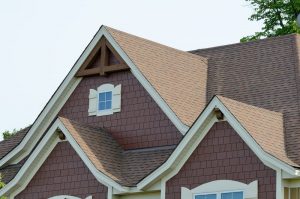Did You Know Your Home’s Roof Isn’t Waterproof?


I think there is a fundamental misconception by homeowners that a home’s roof is waterproof. After all, we always think of sitting inside our homes on a cold, dark, rainy night and being warm and dry. However, we stay that way because a typical home’s roof is water-resistant, not waterproof. This may sound like a minor difference in wording but there is a world of difference between the ways you build a roof to be waterproof versus water-resistant.
How Does My Home’s Roof Work?
With a typical residential home roof, and even most light commercial office buildings that take on a residential look, they are built with a peak. With a home’s design, the peak starts the process of shedding water to the edges of the building. For a simple common gable roof, rain lands on the roof, and in most of the U.S., lands on an asphalt shingle that is layered so that water flows downhill to the edge of the building. It gets to the ground by falling off of the roof or being collecting in a gutter and spouting system to be distributed away from the building.
 However, there are lots of things that can get in the way of the water leaving the building between the peak and the edge of the roof. Complex roof designs give a home a lot of character and curb appeal. They also create a higher amount of complexity when it comes to getting water past the reverse gables, the dormers, the A gables, and many other architectural roof aspects. Add to that a fireplace popping up through the roof or placed on the outside wall of the home and you can start to see why water may not get off the roof quickly.
However, there are lots of things that can get in the way of the water leaving the building between the peak and the edge of the roof. Complex roof designs give a home a lot of character and curb appeal. They also create a higher amount of complexity when it comes to getting water past the reverse gables, the dormers, the A gables, and many other architectural roof aspects. Add to that a fireplace popping up through the roof or placed on the outside wall of the home and you can start to see why water may not get off the roof quickly.
Imagine when that water slows down or backs up. For example, an asphalt shingle roof is layered. If water backs up (pools or puddles) on the roof, it can get back up under the shingles. When that happens there is a good chance it could result in a roof leak. In northern states, something known as an ice dam can occur. A ridge of ice forms on the edge of the roof causing melting snow (water) to build up behind it which can then leak into the home under the shingles. Think expensive water damage.
Building a Better Roof
Over the years many techniques and products have been developed to help eliminate the issues of water getting into a home through the roof. There are also many types of roofing products. They can include asphalt shingles, metal roofs, tile, wood, etc. Here are just a couple examples of products created to help protect homes from water infiltration through the roof:
Roof Underlayments – An underlayment is the product that is placed on the roof before the final roofing material is applied. For instance, most builders place what is known as tar paper or felt paper on roofs in a lapped fashion to help protect the home from water that can get under a shingle. New products, such as Typar’s synthetic underlayment are offering better protection for today’s home.
Ice Shield – In colder climates where ice dams can form, building code requires a product called ice shield be used to protect the home along the roof edges. This product works by adhering to the roof decking, not just being nailed or stapled to it. This means water that puddles can’t get under a shingle and gain exposure to the house or get between the underlayment and the roof sheathing. The ice shield protects the home from this water infiltration.
When is a Roof Leak not a Roof Leak?
When someone sees a water spot in a ceiling or wet areas in their attic they immediately think there is a roof leak. However, you can get water in your home from the roof and not a drop of water came through it. Sound impossible?
RELATED: HOW DOES ROOF DESIGN IMPACT MY HOME’S STYLE?
Building science is real and at work in your roof. Cold and hot air is constantly flowing in most attics. When cold and warm air meet, water vapor is formed. Attics need to be ventilated so air doesn’t stagnate. In most roofs today, vents are placed in the outside eaves of the home. A ridge vent is placed on top of the peak of the home. As the sun warms the roof the air in it heats up and rises. As it exits the top of the roof it pulls in fresh air from the eaves. This continuous process ventilates the attic.
When an attic isn’t properly ventilated something called condensation occurs. Air isn’t moving so water forms on the sheathing under the roof. This water drips onto the ceiling of your home below and pools at the lowest spot it can find. As it builds up, and through the process of time, it eventually finds its way into your home causing extensive damage. If you are lucky enough, you will see it. If you aren’t, this process will occur for years. When you do find it, it can result in tens of thousands of dollars of work to repair the damage caused by the water.
Design the Modular Home Roof
A modular home roof could be considered of feat of engineering. Especially for some of the more sophisticated, complex roof designs you see in the northeast or mid-Atlantic states. Roofs are hinged to lie flat for transport. They can have flipping peaks, flipping eaves, and panelized crickets/saddles. Sounds complicated, doesn’t it. It can be truly amazing how a home built in a factory can be built so that a complex roof in multiple sections can come together and fit. Much like a child’s Transformer® toy, a roof appears from what appeared to be a flat box.
The next time you look at a home’s roof, think about how the water gets from the peak to the ground without getting inside. Look at a very complex roof and just imagine what it took in construction and building product to protect its occupants and the home itself from the elements. There is more that goes into your homes roof than most people will ever imagine.
The post Did You Know Your Home’s Roof Isn’t Waterproof? appeared first on Impresa Modular.




